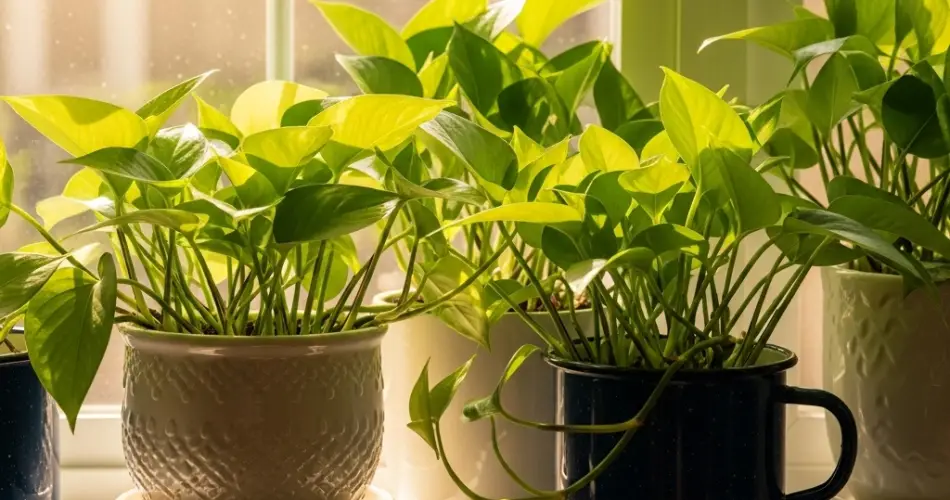Pothos (Epipremnum aureum) is one of the easiest and most forgiving houseplants to grow, making it a favorite among both beginners and experienced indoor gardeners. Known for its trailing vines and heart-shaped leaves, pothos adapts well to a variety of growing conditions and can even thrive in containers placed on a sunny windowsill. With the right care, this resilient plant can flourish year-round and add lush greenery to any indoor space.
This guide will walk you through how to grow and maintain pothos successfully in containers, especially if you’re using a bright windowsill as its home.
Why Choose Pothos for Windowsill Gardening?
Pothos is an ideal plant for indoor settings due to its low maintenance requirements and attractive appearance. Its trailing vines can cascade beautifully from a hanging container or shelf, and its variegated leaves can brighten up any room. When grown on a sunny windowsill, pothos gets enough light to support lush growth, while remaining sheltered from harsh outdoor conditions.
Key benefits include:
-
Excellent air-purifying qualities
-
Fast-growing and easy to propagate
-
Tolerates some neglect
-
Thrives in containers and hanging baskets
Selecting the Right Variety
There are several pothos varieties available, each with unique foliage colors and growth habits. For container growing on a sunny windowsill, consider the following types:
-
Golden Pothos: The classic variety with green and yellow marbled leaves.
-
Marble Queen: A more decorative option with creamy white and green variegation.
-
Neon Pothos: Bright, chartreuse leaves that add a pop of color.
-
Jade Pothos: Solid green leaves, great for lower-light areas but also thrives in bright light.
Choosing the Container
Pothos grows well in a variety of containers, but certain features will help optimize its health:
-
Size: Start with a pot that is 1–2 inches larger than the root ball. Overly large pots can cause water retention and root rot.
-
Drainage: Make sure the container has drainage holes to prevent soggy soil.
-
Material: Terracotta pots are ideal because they allow excess moisture to evaporate, but plastic or ceramic pots also work well.
For a decorative touch, place the pot inside a larger decorative cachepot or use a hanging basket to let the vines trail gracefully down.
Light Requirements for Windowsill Success
Pothos prefers bright, indirect light. A sunny windowsill is usually perfect, as long as the plant is not exposed to intense direct sun for long hours, which can scorch its leaves.
-
South or east-facing windows are best.
-
Filter intense light with a sheer curtain if needed.
-
If leaves fade or burn, move the plant slightly away from the window.
If natural light is limited, pothos can tolerate medium to low light, though growth may slow, and variegation may become less pronounced.
Potting Mix and Soil
Use a well-draining, lightweight potting mix for pothos. A high-quality indoor potting soil with added perlite or orchid bark improves aeration and prevents root rot.
DIY mix idea:
-
2 parts peat-based potting mix
-
1 part perlite
-
1 part coco coir or orchid bark
Avoid dense or garden soil, as it retains too much moisture for container-grown pothos.
Watering and Feeding
Pothos prefers to dry out slightly between waterings. Overwatering is one of the few ways to harm this plant, so follow these watering tips:
-
Water when the top 1–2 inches of soil are dry.
-
In warmer, sunnier conditions, water more frequently (every 7–10 days).
-
In cooler months or low light, reduce watering frequency.
For feeding:
-
Use a balanced, water-soluble fertilizer once a month during spring and summer.
-
Stop fertilizing in fall and winter when growth naturally slows.
Pruning and Training
Regular pruning keeps your pothos looking tidy and encourages bushier growth.
-
Trim back leggy vines to promote branching.
-
Use clean scissors or pruners to avoid damaging stems.
-
Propagate trimmed vines in water to grow new plants.
If you want your pothos to climb, provide a moss pole or trellis. Alternatively, let the vines trail freely for a cascading effect.
Common Problems and Solutions
Yellow leaves: Often caused by overwatering or poor drainage. Check soil moisture and adjust watering frequency.
Brown leaf tips: Usually a result of low humidity or inconsistent watering. Mist the plant or use a pebble tray to increase humidity.
Slow growth: May indicate insufficient light or depleted nutrients. Move to a brighter location and consider light feeding.
Pothos is quite resilient and bounces back quickly from minor issues when given proper care.
Propagation
Pothos is one of the easiest houseplants to propagate. Just cut a 4–6 inch section of vine with at least one node, place it in water, and wait for roots to form. Once rooted, transfer it to soil and watch it grow.
Final Thoughts
Growing pothos in containers on a sunny windowsill is a rewarding and low-effort way to bring greenery into your home. With the right pot, lighting, and watering habits, your pothos will thrive, sending out lush vines and vibrant leaves that freshen up any indoor space. Perfect for beginners and plant lovers alike, this classic houseplant is a must-have for every sunny windowsill.



